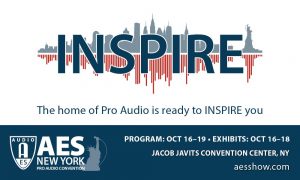AES Show Gets Down to Business
Retaining academic focus, the show adds networked audio, immersive sound
Story Highlights
The Audio Engineering Society’s annual AES Show will take place on Oct. 17-20 at New York City’s Javits Center. As in the previous two years, it will be co-located with what is now branded as the NAB Show New York, which runs Oct. 16-17.
 The latter expo is broadly presented as a showcase for next-generation technology for media, entertainment, and telecom and includes conferences and workshops on television, film, satellite, online video, live events, podcasting, advertising, corporate A/V, production, and post. The AES Show, on the other hand, retains its traditional focus on professional audio. Although its longtime emphasis on music production has waned, with that vertical becoming largely a DIY proposition, the AES Show has broadened its portfolio, adding networked audio and immersive/spatial sound while remaining centered on sound, including broadcast audio, with a solid foundation in the academic white papers that the AES excels at.
The latter expo is broadly presented as a showcase for next-generation technology for media, entertainment, and telecom and includes conferences and workshops on television, film, satellite, online video, live events, podcasting, advertising, corporate A/V, production, and post. The AES Show, on the other hand, retains its traditional focus on professional audio. Although its longtime emphasis on music production has waned, with that vertical becoming largely a DIY proposition, the AES Show has broadened its portfolio, adding networked audio and immersive/spatial sound while remaining centered on sound, including broadcast audio, with a solid foundation in the academic white papers that the AES excels at.
This year’s broadcast-conference program reflects what those professionals are thinking about. The Broadcast & Online Delivery Track will present in-depth examinations of trends like podcasting, which occupies the space between Ethernet and the ether, and object-based mixing. But panels like Performance Spaces for Broadcast, which acknowledges how much of what’s on the air is live, inch closer to the live event embodied by sports.
That all comes together in Creating an Immersive Audio Experience in Live Sports, where panelists Mike Babbitt (Dolby Laboratories), Dennis Baxter (Dennis Baxter Sound), Karl Malone (NBC Universal), and Patrick Warrington (Lawo) look at the creative and technical challenges and questions involved in creating a more compelling experience for the viewer. What is the perspective of the listener—as an observer, a participant, or a mix of both? How does one leverage height in a mix when there are no obvious sound cues from above? Is a multi-bus mix console sufficient for mixing immersive audio? How do you mix for a wide range of listening environments, including immersive, 5.1, stereo, soundbars, and headphones?
Other broadcast-centric panels are Sound Knowledge: Learn How SMPTE ST 2110 Helps Audio Stand Out; Facility Designed for IP; Immersive Audio Mixing and Workflow for Broadcast; and Convergence of Broadcast Over-the-Air and Streaming Delivery.
Standards organizations will also be well represented on the conference program. Alliance for IP Media Solutions (AIMS) will again collaborate to create a professional-media–networking pavilion at the convention. Central to the pavilion will be the AV-over-IP Technology Pavilion Theater, featuring a continuous program of 30-minute presentations covering a wide range of topics relating to delivery of audio and video over IP. The scope of this year’s pavilion will be expanded to include video topics, but expect to hear a lot about the most buzzworthy of alphanumerical denominators: AES67; SMPTE’s ST 2110 suite of standards for Professional Media Over Managed IP Networks; AMWA NMOS specifications, such as IS-04, IS-05, IS-07, and IS-08; timing and synchronization using SMPTE ST 2059-1/2; and the JT-NM TR-1001-1 framework for installing, configuring, and interconnecting equipment.
In short, the AES Show may be leaner than in its battleship-size–console heyday of the 1980s and ’90s, but it has re-emerged in recent years as a more highly focused conclave, with an emphasis on the academic techno-knowledge base that the organization has always excelled at fostering combined with a newly honed sense of the practical exigencies of today’s pro-audio industry.
